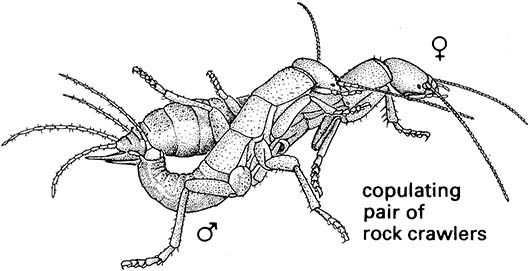Box 9.4. Grylloblattodea (Grylloblattaria, Notoptera; grylloblattids, ice or rock crawlers)
Grylloblattodea comprise a single family, Grylloblattidae, containing some 25 described species, restricted to western North America and central to eastern Asia including Japan. North American species are particularly tolerant of cold and may live at high elevations on glaciers and snow banks; East Asian species may live at sea level in temperate forest. Grylloblattodea are moderately sized insects (20–35 mm long) with an elongate, pale, cylindrical body that is soft and pubescent. The head is prognathous, and the compound eyes are reduced or absent; ocelli are absent. The antennae are multisegmented, and the mouthparts mandibulate. The quadrate prothorax is larger than the meso- or metathorax; wings are absent. The legs are cursorial, with large coxae and five-segmented tarsi. The abdomen has 10 visible segments and the rudiments of segment 11, with five- to nine-segmented cerci. The female has a short ovipositor, and the male genitalia are asymmetrical.
Copulation takes place side-by-side with the male on the right, as illustrated here for a common Japanese species, Galloisiana nipponensis (after Ando 1982). Eggs may diapause up to a year in damp wood or soil under stones. Nymphs, which resemble adults, develop slowly through eight instars. North American rock crawlers are active by day and night at low temperatures, feeding on dead arthropods and organic material, notably from the surface of ice and snow in spring snow-melt, within caves (including ice caves), in alpine soil, and damp places such as beneath rocks.
Phylogenetic relations are discussed in section 7.4.2 and depicted in Fig. 7.2.


Broken lines indicate uncertain relationships. Thysanura sensu lato refers to Thysanura in the broad sense. (Data from several sources)



